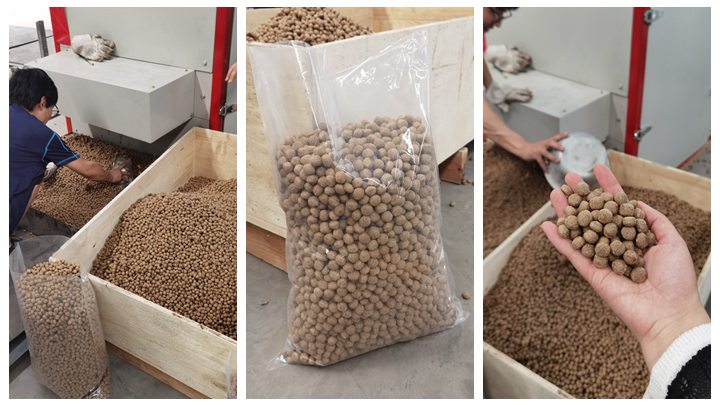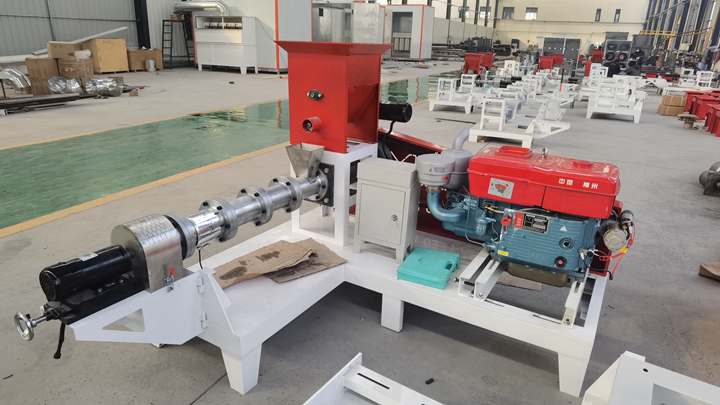.jpg)
Jan 29, 2021 · (1)Dry type fish feed extruder does not need the steam boiler, so the dry type fish feed pellet machine is cheaper and easier to use and operate. (2)The feed pellet made by wet type fish feed pellet machine is more smooth and with better quality because the material is ripen and mixed enough in the conditioner compared with the dry type extruder.
.jpg)
8-10 T/H Fish Feed Pellet Extruder. The RCPH185*2 fish feed pellet extruder machine use a kind of general-purpose equipment to produce extruded pellets according to the demands. Multi-screw coaxial extruding, feed output is increased obviously, abrasion of wearing parts is more uniform, discharging is smoother and pellet uniformity is better.
.jpg)
Wet Way Floating Fish Feed Extruder. Twin Screw Wet Way Floating Fish Feed Extruder. 40-300kg/h Fish Feed Production Line. 200-800kg/h Automatic Fish Feed Production Line. Flat Die Animal Feed Pellet Machine. Ring Die Poultry Feed Pellet Making Machine. 200-1000kg/h Poultry Feed Production Line. Feed Grinder.
.jpg)
Oct 12, 2015 · Wet type fish feed machine is widely used for producing grains into high-grade aquatic feed pellets for many kinds of pet like fish, catfish, shrimps, crab, cat, dog and etc. Grain materials
.jpg)
For a cheap, easy-to-operate, yet reliable pellet making machine for a small-scale or medium-scale fish pellet plant, the dry type fish feed extruder is highly recommended. For large factories however, the wet type feed extruder that has a conditioner will be able to produce in large quantity, a high quality fish feed pellet.
.jpg)
The feed pellet made by wet type fish feed pellet machine is more smooth and of better quality because the material is ripened and mixed enough in the conditioner compared with the dry type extruder. The diameter of the pellets can be from 0.9mm-15mm.

Fish Feed Pellet Extruder. Model: DGP & DSP. Capacity: 0.03-4t/h. DSP Wet Type Fish Feed Extruder. Model: DSP Series. Capacity: 0.18-4t/h. DGP Dry Type Fish Feed Extruder. Model: DGP Series. Capacity: 300kg/h - 2t/h
.jpg)
1 day ago · As pellet mills use compressive force to bind the pellet together, it is important to use higher quality raw material and additional binders. An example would be the need to use higher starch amounts in pelleted feeds as compared to extruded feeds.
.jpg)
The wet-type fish feed extruder machine is widely used in making both floating fish feed and sinking feed pellets for aquaculture farms, feed mills, livestock farms, and poultry farms. Different from the dry type floating fish feed pellet mill , the wet type is equipped with a boiler that can continuously steam the materials to make pellets.
.jpg)
Fish Feed Pet Food Extruder Machine. floating fish feed extruder machine,floating fish feed pellet mill, is mainly utilized for making floating fish feed pellets or sinking, slow sinking fish feed for dog and cat. You can also use it to make extruded feather meal .as a protein additive to replace fish meal. Click for Price List Now!
.jpg)
1. A dry-type extruder is a type of machine that does not require a steam boiler for heat steam injection or jacket heating, so it is cheaper than the wet type, and it is for small and medium fish farms. 2. The heart of wet type fish feed extruder machine working is: preconditioning, cooking, and die shaping. High temperature and high-pressure

pellet feed and extruded feed has their own disadvantages and advatages when comparing pelleted feed vs extruded feed. Extruded Feed: Extruded feeds may contain more fat than pelleted feeds because too much fat can cause the pellets to fall apart. Higher fat means higher calories, which is a benefit for many categories of horses, including hard
.jpg)
So the dry type fish feed pellet extruder machine is cheaper and easier to use and operate. 2. The feed pellet made by wet type fish feed pellet machine is more smooth and with better quality because the material is ripen and mixed enough in the conditioner compared with the dry type extruder. 3. The capacity of the wet type is higher than the
.jpg)
Feb 4, 2016 · Raw Material for Fish Feed Pellets. raw materials include farmed products such as soy bean, rape seed, and wheat, rice by-products: husk rice, bran rice and brown broken rice from evergreen mills